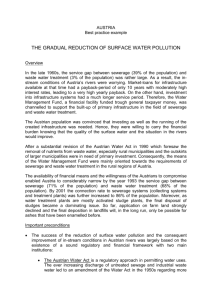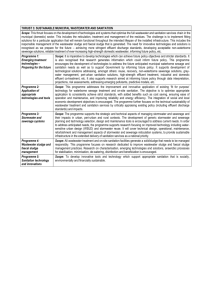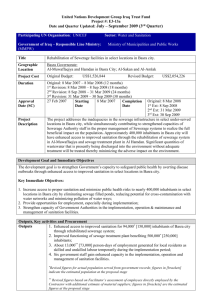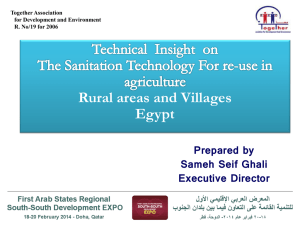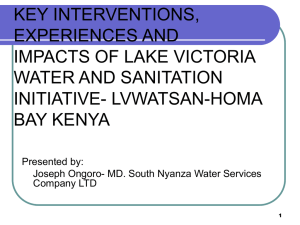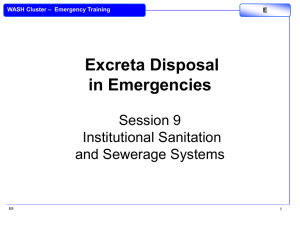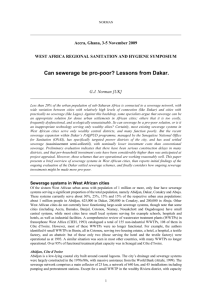Annex-13 - Department of Water Supply and Sanitation, Punjab
advertisement
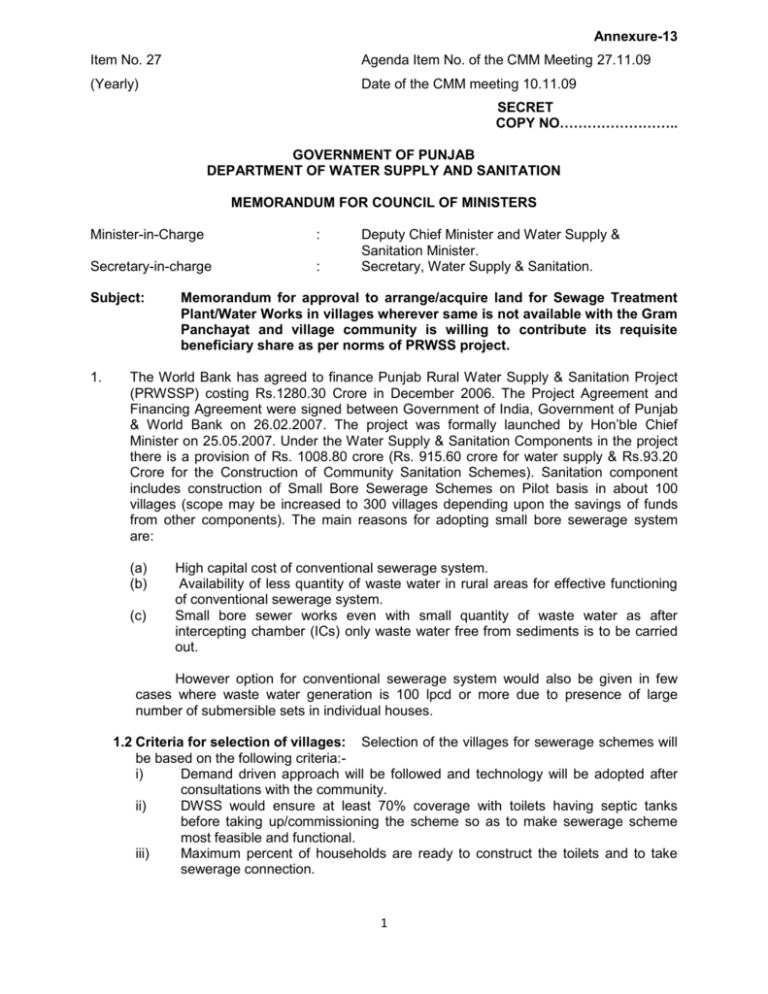
Annexure-13 Item No. 27 Agenda Item No. of the CMM Meeting 27.11.09 (Yearly) Date of the CMM meeting 10.11.09 SECRET COPY NO…………………….. GOVERNMENT OF PUNJAB DEPARTMENT OF WATER SUPPLY AND SANITATION MEMORANDUM FOR COUNCIL OF MINISTERS Minister-in-Charge : Secretary-in-charge : Subject: 1. Deputy Chief Minister and Water Supply & Sanitation Minister. Secretary, Water Supply & Sanitation. Memorandum for approval to arrange/acquire land for Sewage Treatment Plant/Water Works in villages wherever same is not available with the Gram Panchayat and village community is willing to contribute its requisite beneficiary share as per norms of PRWSS project. The World Bank has agreed to finance Punjab Rural Water Supply & Sanitation Project (PRWSSP) costing Rs.1280.30 Crore in December 2006. The Project Agreement and Financing Agreement were signed between Government of India, Government of Punjab & World Bank on 26.02.2007. The project was formally launched by Hon’ble Chief Minister on 25.05.2007. Under the Water Supply & Sanitation Components in the project there is a provision of Rs. 1008.80 crore (Rs. 915.60 crore for water supply & Rs.93.20 Crore for the Construction of Community Sanitation Schemes). Sanitation component includes construction of Small Bore Sewerage Schemes on Pilot basis in about 100 villages (scope may be increased to 300 villages depending upon the savings of funds from other components). The main reasons for adopting small bore sewerage system are: (a) (b) (c) High capital cost of conventional sewerage system. Availability of less quantity of waste water in rural areas for effective functioning of conventional sewerage system. Small bore sewer works even with small quantity of waste water as after intercepting chamber (ICs) only waste water free from sediments is to be carried out. However option for conventional sewerage system would also be given in few cases where waste water generation is 100 lpcd or more due to presence of large number of submersible sets in individual houses. 1.2 Criteria for selection of villages: Selection of the villages for sewerage schemes will be based on the following criteria:i) Demand driven approach will be followed and technology will be adopted after consultations with the community. ii) DWSS would ensure at least 70% coverage with toilets having septic tanks before taking up/commissioning the scheme so as to make sewerage scheme most feasible and functional. iii) Maximum percent of households are ready to construct the toilets and to take sewerage connection. 1 iv) v) vi) vii) Village should have water supply scheme or is being implemented with minimum service level as 70 Ipcd & with additional average 20 lpcd consumption for nondrinking usage from private sources. The Panchayat will provide 3 to 5 Acre of land free of cost for construction of sewerage treatment plant. Feasibility of disposal of treated effluents either onto land or in water bodies. Willingness of the community and GP to abide by the user cost sharing rules of the project for community sanitation. According to modified cost sharing rules: “10% of the capital cost is to be provided by users subject to a maximum of Rs. 800/- per household but for household in difficult area contribution would be 5% subject to maximum of Rs. 400/- per household. For SC households contribution amount would be 50% of the prescribed amount.” For sanitation schemes as far as possible, beneficiary share will be realized from all households of a village but to make contribution equal to 10% of the scheme cost for general villages & 5% of scheme cost for villages located in difficult areas, the following provisions are available in the cost sharing rules: (i) (ii) (iii) Other funds such as GPs external funds, NRI Donations, etc. can be used to meet the 'contribution' upto 30% of the total beneficiary share and GPs may contribute a maximum of 20% of the contribution and remaining 50% will be contributed by the users. In case MPLADs funds are to be used then its contribution shall be equal to 50% of the community share and the remaining 50% community share will be contributed by the users. Where the contribution made by the community falls short of the target amount (10% of scheme cost for general villages and 5% of scheme cost for difficult areas), the gap is to be filled-up following a stepped approach, first, by raising voluntary contribution from the community; second, through non-budgetary resources of the GP; third, by accessing untied funds available with the district administration; and lastly, through state government grant. Compliance with this principle is to be certified by a credible agency, such as the NGO working in the respective GP or reputed civil society organization. 1.3 Constraints to join the project: As mentioned above in para 2 (v) as per project concept the Panchayat will provide 3 to 5 Acre of land free of cost for construction of sewerage treatment plant. Basic reason for the requirement of more area of land for the treatment plant is due to the adoption of low cost sewerage treatment technologies based on the construction of stabilization ponds. As of now 31 panchayats (list enclosed as annexure A) in 5 districts of the State have submitted resolution for installation of sewerage system along with sewage treatment plants in their villages. However, out of these 31 panchayats land for installation of sewage treatment plants is available only in 11 villages. Due to non availability of land for constructing sewage treatment plants, the sewerage schemes in remaining 20 villages are not feasible. It has been ascertained during the field visits by the NGOs and IEC and HRD Specialists working in SPMC that many panchayats are willing to contribute minimum prescribed beneficiary share required for sewerage scheme but due 2 to non availability of 3 to 5 acres of panchayat land in their village, they are unable to join the project. 1.4 Similarly requirement of land for constructing water works based on tubewell is comparatively less and so far no panchayat has encountered any problem for providing land for water works site. However for water works based on canal water supply system not only the requirement of land is more (minimum 4 acres) but it is also preferred near the canals. Water supply schemes in the districts of Faridkot, Muktsar, Bathinda and Mansa are mostly based on canal water supply system. Some panchayats in these districts have collected community contribution as per project rules but are unable to provide required land at suitable location. Due to non availability of panchayat land and thus cannot join the project. 2 3 4 5 Proposal: In view of constraints mentioned in para 1.3 & 1.4 pertaining to non availability of panchayat land required for sewerage treatment plant and non availability of adequate land at specific location for constructing water works it is proposed that in all such cases government may procure/acquire land through its own resources like small savings award funds, PIDB, Rural Development Fund, State Plan Budget or any other source. The gap in the target amount of 10% of the scheme cost for general villages and 5% of the scheme cost for villages in difficult areas is to be provided through State Government grant as illustrated above in the modified cost sharing rules and as such this arrangement would not dilute the project concepts and can be adopted to utilize the complete project funds available with the State Government which otherwise may lapse. As such, approval of the Council of Ministers is solicited to the proposal contained in para 2 of this memorandum. The proposal contained in the memorandum has been seen and approved by the Water Supply & Sanitation Minister as Minister-In charge of the Department of Water Supply & Sanitation. Permission of the Chief Minister has been obtained for placing this memorandum before the Council of Ministers. Dated, Chandigarh 09th November 2009 P.S. Aujla Secretary to Govt. Punjab Department of Water Supply & Sanitation 3
